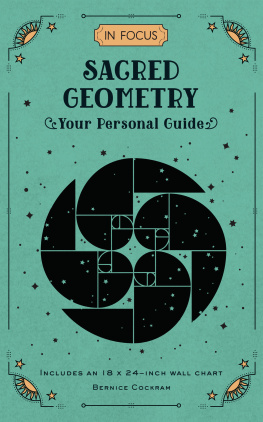Bernice Cockram - In Focus Sacred Geometry
Here you can read online Bernice Cockram - In Focus Sacred Geometry full text of the book (entire story) in english for free. Download pdf and epub, get meaning, cover and reviews about this ebook. year: 2020, publisher: Wellfleet Press, genre: Children. Description of the work, (preface) as well as reviews are available. Best literature library LitArk.com created for fans of good reading and offers a wide selection of genres:
Romance novel
Science fiction
Adventure
Detective
Science
History
Home and family
Prose
Art
Politics
Computer
Non-fiction
Religion
Business
Children
Humor
Choose a favorite category and find really read worthwhile books. Enjoy immersion in the world of imagination, feel the emotions of the characters or learn something new for yourself, make an fascinating discovery.
- Book:In Focus Sacred Geometry
- Author:
- Publisher:Wellfleet Press
- Genre:
- Year:2020
- Rating:4 / 5
- Favourites:Add to favourites
- Your mark:
- 80
- 1
- 2
- 3
- 4
- 5
In Focus Sacred Geometry: summary, description and annotation
We offer to read an annotation, description, summary or preface (depends on what the author of the book "In Focus Sacred Geometry" wrote himself). If you haven't found the necessary information about the book — write in the comments, we will try to find it.
In Focus Sacred Geometry — read online for free the complete book (whole text) full work
Below is the text of the book, divided by pages. System saving the place of the last page read, allows you to conveniently read the book "In Focus Sacred Geometry" online for free, without having to search again every time where you left off. Put a bookmark, and you can go to the page where you finished reading at any time.
Font size:
Interval:
Bookmark:



W hat is sacred geometry? Geometry at its basic level is the design of shapes based on mathematics; geometry literally means earth measure, as geo refers to the earth and metry to measurements. Geometric shapes are so much a part of our everyday life that we may not even notice just how frequently they can be found. Hopefully, after reading this book, you will start to see many examples that you never noticed before.
Mathematicians have studied geometry for thousands of years. The early mathematicians marveled at the perfection of their calculations, and they attributed this perfection to the Creatorthis is how geometry came to be sacred.
Geometry began to be used in a symbolic way, especially in religion, due to the fact that the general population were not able to read and write, but they were able to recognize shapes. Some shapes were also used symbolically in secret societies, where only the members of the society would understand their meaning.
People have searched for the meaning behind mathematical patterns for thousands of years. The Egyptian Rhind Papyrus from ca. 20001800 BCE is one of the earliest known writings on geometry, along with the Moscow Papyrus from ca. 1890 BCE and the Babylonian clay tablets of ca. 20001800 BCE.
Some of the most notable published discoveries are works from:
Thales of Miletus (ca. 624ca. 546 BCE), a Greek mathematician, discovered that geometry could be used to calculate the height of pyramids and also a ships distance from the shore.
Pythagoras (ca. 570ca. 495 BCE), a Greek philosopher, set up a school to study geometry in ca. 530 BCE. His students were referred to as Pythagoreans.
Plato (ca. 427347 BCE), a Greek philosopher, was the founder of the Academy in Athens and discovered the Platonic solids.
Euclid (ca. 330275 BCE), a Greek mathematician, had his findings published in a 1570 book called Elements that was a collection of geometric studies from several mathematicians.
Archimedes (ca. 287212 BCE), a Greek mathematician, created the Archimedean solids and the Archimedean spiral.
Leonardo Pisano (ca. 1170after 1240), better known as Fibonacci, was an Italian mathematician who wrote Liber Abaci (Book of the Abacus) in which he introduced the number series today referred to as the Fibonacci sequence.
Luca Pacioli (ca. 14471517) was an Italian mathematician who wrote Divina Proportione (Divine Proportion), a book about mathematical proportions in architecture, polygons, art, and which was illustrated by Leonardo da Vinci.
Johannes Kepler (15711630 BCE) was a German mathematician and astronomer. Although most commonly known for his observations on the paths of the planets, he also made some important discoveries with geometry.
There have been many other mathematicians that have advanced our appreciation for and understanding of the patterns and symbolism of sacred geometry, but those above are referred to later in the book.
Another very important name is Drunvalo Melchizedek. He introduced sacred geometry to the world in a series of workshops from 1985 to 1994. If you would like to find out more about sacred geometry, I would highly recommend reading some of his work.
Throughout this book you will discover many different shapes and their meanings as you learn about the shapes themselves as well as how sacred geometry appears in letters, numbers, art, architecture, and religious symbols. You will even find out about the math behind it all. After all, sacred geometry appeals to us on many levels, as the shapes formed are often symmetrical and balanced; we are always subconsciously seeking balance in mind, body, and spirit, and so people use these shapes just about everywhere in the world.
Sacred geometry can be incorporated into your own everyday life and spiritual practices in a number of ways: through artwork, room and garden design, meditations, and visualizations, to name just a few. As you learn more about the shapes and the many places they can be found, you will find suggestions for different ways of working with sacred geometry.
Enclosed Sacred Geometry Wall Chart Included in this book is a wall chart that serves as a quick and handy reference guide containing a summary of the essentials of sacred geometry from the following pages.

S hapes with two dimensions have height and length/width, and are essentially flat. If the shape has straight sides, it is called a polygon. This word is Greek in origin, poly meaning many and gon being short for gonia, which means angle. The polygons described in this chapter are all regular, meaning they all have the same interior angles. In an irregular shape, some of the angles will be different. Although this chapter is about two-dimensional shapes, we cannot begin without first talking about the line.
Lines are one-dimensional, which means they have length but no width or height. A line can be a boundary or a partition. Lines can be connections, so a line can travel from point a to point b. Lines can be used to emphasize, as in an underline , or they can express dissatisfaction by striking through words. We have linear graphs and starting lines, we are used to standing in line, and there are many sayings that revolve around the word line, such as:
- Hold the line
- Lifeline
- Toe the line
- A fine line
- Between the lines
Over the years, many symbolic meanings have been attributed to lines, from ancient cave art to sacred religious symbols. Generally speaking, straight lines are considered masculine, and curves, arcs, and circles are considered feminine. When it comes to geometry, however, numbers play a large part, because even numbers are considered feminine, while odd numbers are masculine, except for the number one. One was historically held in great esteem, and it was seen as the basis of everything, much like the line. The line is the starting point of this book, just as it is the starting point of all geometry.
Just as life starts with a single cell, the first shape of sacred geometry is the circle. Circles have been regarded as important since ancient times. The sun and the moon were worshipped as a god and a goddess, while the discovery of the wheel had a huge impact on how our ancestors lived. The circle was referred to as monad, meaning one, by the Pythagoreans, and it represented the origin of all things. This is the shape that was attributed to the Creator, embodying perfection and wholeness. With this connection to the divine, the circle came to represent the same characteristics of the Creator, which are wisdom, unity, and perfection. It can also depict nothingness because a circle can be equated to zero and the absence of something. In astrology, a circle with a dot in the center represents the sun, and like the sun, this symbol is considered masculine. In Norse mythology and some religions, the sun is represented by a circle with a cross inside.
Font size:
Interval:
Bookmark:
Similar books «In Focus Sacred Geometry»
Look at similar books to In Focus Sacred Geometry. We have selected literature similar in name and meaning in the hope of providing readers with more options to find new, interesting, not yet read works.
Discussion, reviews of the book In Focus Sacred Geometry and just readers' own opinions. Leave your comments, write what you think about the work, its meaning or the main characters. Specify what exactly you liked and what you didn't like, and why you think so.








